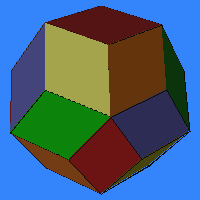By adopting the colors from the faces of the five-colored five cubes, we see the faces of the rhombic triacontahedron can be colored with five colors, in groups of six, so that for each face there is one opposite face, and four orthogonal faces, all of the same color. Here is the five-colored rhombic triacontahedron. Be sure and rotate it and observe the colors. You could place it on a table with a red face on the surface of the table, a red face on top, a red face on the left and right, and a red face at the front and back. This corresponds to aligning the red cube with the table. The other four colors are analogous.
This may be my favorite polyhedron. (It is so hard to choose!) It is an archimedean dual, the dual of the quasi-regular icosadodecahedron. It is also a zonohedron, and leads to an attractive zonohedrification. The ratio of the length of the long diagonal to the length of the short diagonal is the golden ratio. It also lends itself to beautiful stellations and a beautiful dissection into twenty pieces. Furthermore, the shape is easily obtainable in the form of dice.
This polyhedron is generally attributed to Kepler. It is first discussed and analyzed in his 1619 book Harmonies of the World. However, Wentzel Jamnitzer certainly had some concept of it, as it is plainly visible in the left-hand "monument" in this image from his 1568 book Perspectiva Corporum Regularium.
Here are two good follow-up visualization exercises:
Exercise 1: Imagine what would result if you removed one cube from the compound of five cubes.
Answer: You would get this compound of 4 cubes. Note its tetrahedral symmetry: four 3-fold axes of symmetry, three 2-fold axes, and three mirror planes.
Exercise 2: What would its interior look like ?
Hint: It is a partial stellation of the rhombic triacontahedron. Six of the faces (one cube's worth) are removed, i.e., covered over by extensions of a neighboring face, leaving 24 faces.
Answer: It looks like this, but I don't know what to call it. (Crystallographers call a very similar shape a "diploid" but I don't find that very meaningful.)
